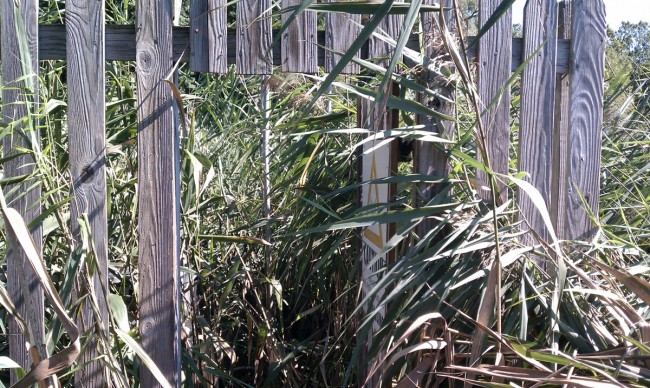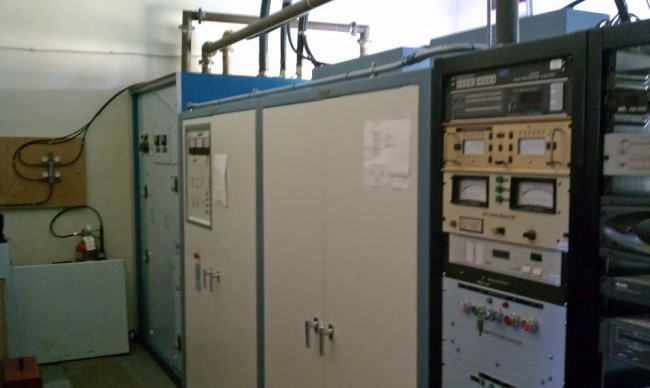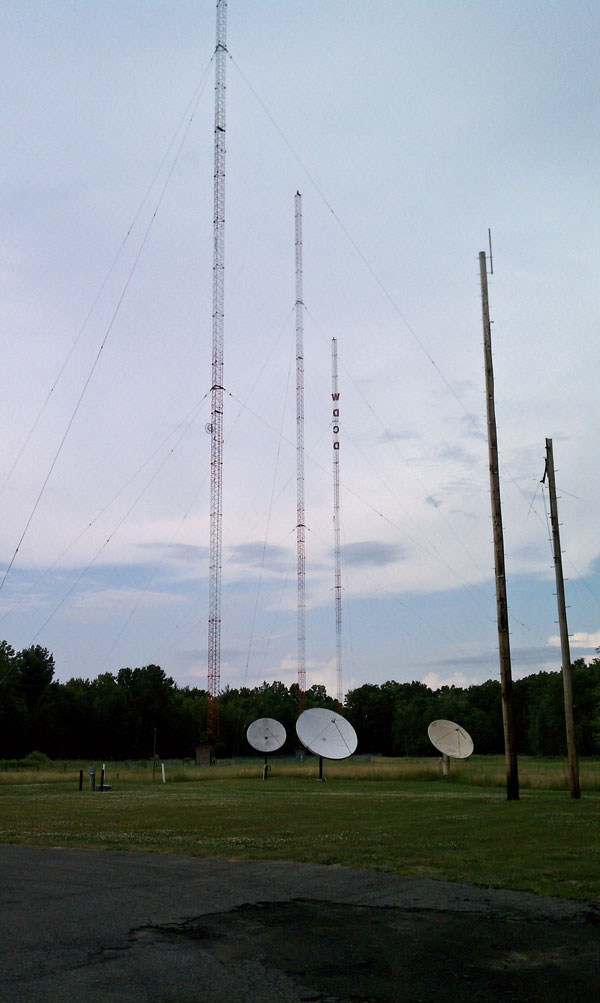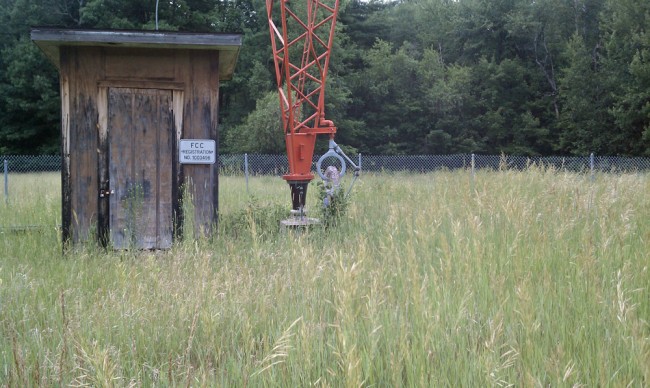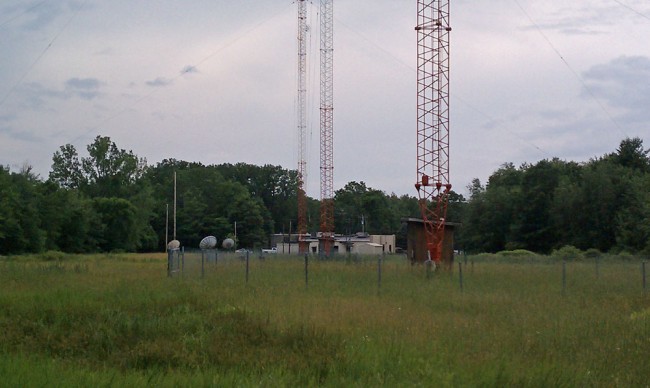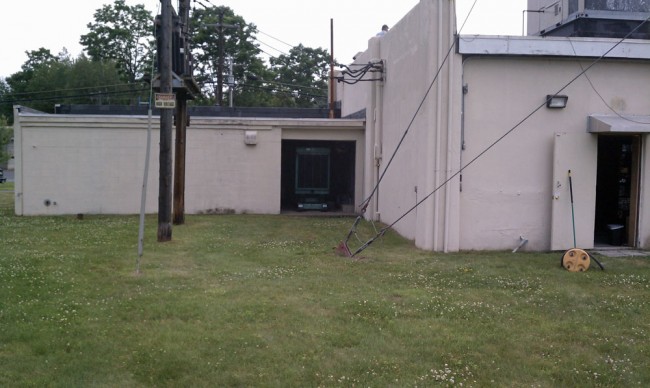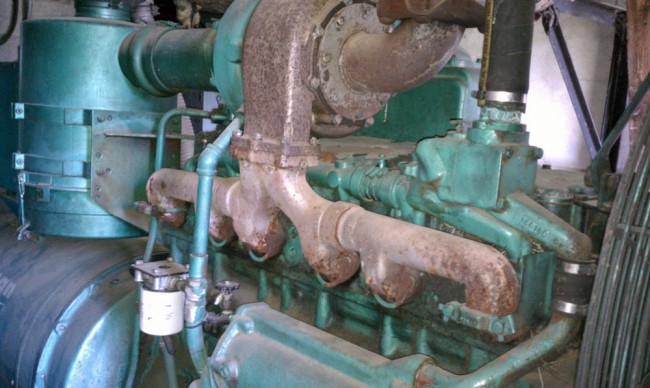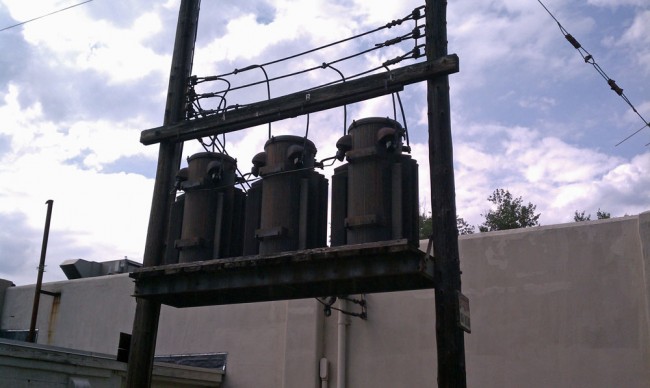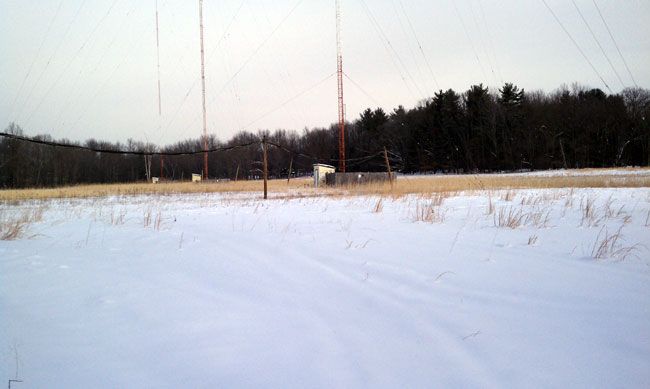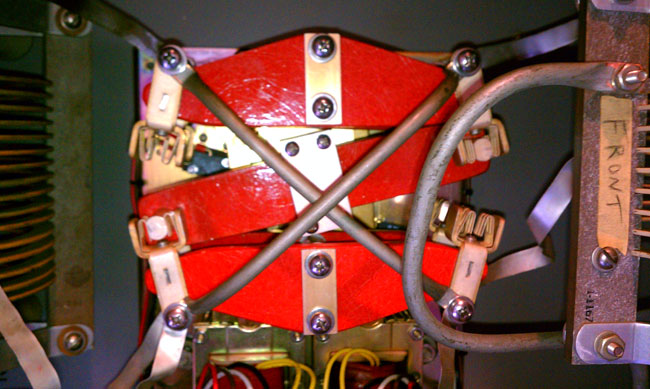This is one of the possibilities that has been bantered about as a solution for the “AM problem.” The theory goes as such; former TV channels 5 and 6 (76 – 88 MHz), which are not suitable for DTV would be an ideal place for the existing AM stations to move. That represents a 12 MHz chunk of spectrum, which is much more than the current 1.16 MHz spectrum the current AM broadcasting service takes up (.54 to 1.7 Mhz). An added benefit is that the VHF spectrum does not have the skywave “problem” that the MF spectrum does, thus many more stations could be licensed to the service. Everyone would benefit, and AM stations would get a new lease on life in the FM band. The number of stations would increase by several fold, including LPFM, non-commercial, and translators. AM stations would no longer be burdened with expensive directional arrays or substandard audio quality.
It seems almost too good to be true…
The FCC reportedly promised “take a hard look” at this idea back in 2008. Four years later, one wonders what has become of it.
A quick search of the existing TV stations licensed to channels 5 and 6 reveals the flaw in this theory. The FCC has re-licensed many full powered and Low Powered DTV stations to channels 5 and 6 since 2008.
List of full power channel 5 stations:
| Call Sign | Service | Status | City | State | Fac ID | ERP (kw) | HAAT (m) | Licensee |
| WOI-DT | DT | LIC | AMES | IA | 8661 | 13.9 | 566 | CAPITAL COMMUNICATIONS COMPANY, INC. |
| WGVK | DT | LIC | KALAMAZOO | MI | 24783 | 10 | 169 | GRAND VALLEY STATE UNIVERSITY |
| WBKP | DT | LIC | CALUMET | MI | 76001 | 6.4 | 301 | LAKE SUPERIOR COMMUNITY BROADCASTING CORPORATION |
| KXLF-TV | DT | LIC | BUTTE | MT | 35959 | 10 | 588 | KXLF COMMUNICATIONS, INC. |
| KXGN-TV | DT | LIC | GLENDIVE | MT | 24287 | 1 | 152.4 | GLENDIVE BROADCASTING CORP. |
| KHAS-TV | DT | LIC | HASTINGS | NE | 48003 | 45 | 217 | HOAK MEDIA OF NEBRASKA LICENSE, LLC |
| WLMB | DT | LIC | TOLEDO | OH | 17076 | 10 | 155 | DOMINION BROADCASTING, INC. |
| KOBI | DT | LIC | MEDFORD | OR | 8260 | 6.35 | 823 | CALIFORNIA OREGON BROADCASTING, INC. |
| KIVV-TV | DT | LIC | LEAD | SD | 34348 | 9.2 | 561 | KEVN, INC. |
| WTVF | DT | LIC | NASHVILLE | TN | 36504 | 22 | 425 | NEWSCHANNEL 5 NETWORK, LLC |
| WMC-TV | DT | LIC | MEMPHIS | TN | 19184 | 34.5 | 308 | WMC LICENSE SUBSIDIARY, LLC |
| KCWX | DT | LIC | FREDERICKSBURG | TX | 24316 | 23.7 | 412 | CORRIDOR TELEVISION, L.L.P. |
| WCYB-TV | DT | LIC | BRISTOL | VA | 2455 | 29.9 | 743 | BLUESTONE LICENSE HOLDINGS INC. |
| WDTV | DT | LIC | WESTON | WV | 70592 | 10 | 240 | WITHERS BROADCASTING COMPANY OF WEST VIRGINIA |
| WIWN | DT | LIC | FOND DU LAC | WI | 60571 | 9 | 338 | WWAZ LICENSE, LLC |
List of Low Power Channel 5 stations (analog):
| Call Sign | Service | Status | City | State | Fac ID | ERP (kw) | HAAT (m) | Licensee |
| KSCT-LP | TX | LIC | SITKA | AK | 15348 | 0.049 | 0 | DAN ETULAIN |
| K05KF | TX | LIC | DILLINGHAM | AK | 792 | 0.16 | 0 | ALASKA CORP OF SEVENTH DAY ADVENTIST |
| KRDN-LP | TX | LIC | REDDING | CA | 127179 | 0.6 | 0 | KM COMMUNICATIONS, INC. |
| W05CO | TX | LIC | SARASOTA | FL | 66995 | 3 | 0 | THREE ANGELS BROADCASTING NETWORK, INC. |
| W05CJ | TX | LIC | KEY WEST | FL | 125642 | 0.59 | 0 | JAMES J. CHLADEK |
| DKHHB-LP | TX | LIC | HILO | HI | 126233 | 3 | 0 | KHHB, LLC |
| WIKY-LP | TX | LIC | EVANSVILLE, ETC. | IN | 61036 | 0.14 | 0 | ROBERTS BROADCASTING COMPANY OF EVANSVILLE, IN, LLC |
| K05IV | TX | LIC | PARK RAPIDS | MN | 55374 | 0.019 | 0 | RED RIVER BROADCAST CO., LLC |
| W05BV | TX | LIC | STARKVILLE | MS | 21634 | 0.066 | 0 | FIRST UNITED METHODIST CHURCH |
| K05LU | TX | LIC | JEFFERSON CITY | MO | 128520 | 0.11 | 0 | HISPANIC CHRISTIAN COMMUNITY NETWORK, INC. |
| K05LY | TX | LIC | MOBERLY | MO | 128560 | 0.1 | 0 | HISPANIC CHRISTIAN COMMUNITY NETWORK, INC. |
| KSXC-LP | TX | LIC | SOUTH SIOUX CITY | NE | 128012 | 3 | 0 | VENTURE TECHNOLOGIES GROUP, LLC |
| K05KY | TX | LIC | LINCOLN CITY | OR | 129190 | 2.25 | 0 | MICHAEL MATTSON |
| K05KX | TX | LIC | TILLAMOOK | OR | 129194 | 0.65 | 0 | MICHAEL MATTSON |
| KRCW-LP | TX | LIC | PORTLAND | OR | 35151 | 2.7 | 0 | TRIBUNE BROADCAST HOLDINGS, INC., DEBTOR-IN-POSSESSION |
| K05LE | TX | LIC | ASTORIA | OR | 129161 | 2.5 | 0 | MICHAEL MATTSON |
| KJIB-LP | TX | LIC | CLEAR LAKE CITY | TX | 21184 | 0.103 | 0 | FAR EASTERN TELECASTERS |
| KLUF-LP | TX | LIC | LUFKIN | TX | 28937 | 0.094 | 0 | INTERNATIONAL BROADCASTING NETWORK |
| K05EF | TX | LIC | BRADY, ETC. | TX | 10043 | 0.068 | 0 | FOSTER CHARITABLE FOUNDATION, INC. |
| KTXF-LP | TX | LIC | ABILENE | TX | 130840 | 0.665 | 0 | KM COMMUNICATIONS, INC. |
List of Low Power Channel 5 stations (digital)
| Call Sign | Service | Status | City | State | Fac ID | ERP (kw) | HAAT (m) | Licensee |
| K05FW-D | LD | LIC | GIRDWOOD | AK | 796 | 0.061 | 0 | ALASKA PUBLIC TELECOMMUNICATIONS, INC. |
| K05ET-D | LD | LIC | LIKELY | CA | 8240 | 0.25 | 0 | CALIFORNIA OREGON BROADCASTING, INC. |
| K05CR-D | LD | LIC | HAYFORK | CA | 68112 | 0.007 | 0 | TRINITY COUNTY OFFICE OF EDUCATION |
| K05CF-D | LD | LIC | WEAVERVILLE | CA | 71381 | 0.015 | 0 | WEAVERVILLE TRANSLATOR CO., INC. |
| K05FR-D | LD | LIC | CROWLEY LAKE | CA | 43512 | 0.06 | 0 | MONO COUNTY SERVICE AREA NO. 1 |
| K05DQ-D | LD | LIC | BURNEY, ETC. | CA | 8314 | 0.045 | 0 | BLUESTONE LICENSE HOLDINGS INC. |
| K05LI-D | LD | LIC | WEBER CANYON | CO | 130882 | 0.0023 | 0 | SOUTHWEST COLORADO TV TRANSLATOR ASSOCIATION |
| K05GA-D | LD | LIC | DOLORES | CO | 61470 | 0.0052 | 0 | SOUTHWEST COLORADO TV TRANSLATOR ASSOCIATION |
| K05JW-D | LD | LIC | ISMAY CANYON | CO | 61449 | 0.0024 | 0 | SOUTHWEST COLORADO TV TRANSLATOR ASSOCIATION |
| K05MD-D | LD | LIC | CRIPPLE CREEK, ETC. | CO | 167809 | 1.5 | 0 | TUCK PROPERTIES, INC. C/O LEE PELTZMAN |
| WRUF-LD | LD | LIC | GAINESVILLE | FL | 4200 | 0.3 | 0 | BOARD OF TRUSTEES, UNIVERSITY OF FLORIDA |
| K05GL-D | LD | LIC | COOLIN | ID | 53516 | 0.013 | 0 | PRIEST LAKE TRANSLATOR DISTRICT |
| K05EY-D | LD | LIC | TERRACE LAKES | ID | 23150 | 0.065 | 0 | GARDEN VALLEY TRANSLATOR DISTRICT |
| K05BE-D | LD | LIC | LEHMI, ETC | ID | 58708 | 0.013 | 0 | SALMON TV TRANSLATOR DISTRICT |
| W05DD-D | LD | LIC | ST. FRANCIS | ME | 39652 | 0.097 | 0 | MAINE PUBLIC BROADCASTING CORPORATION |
| K05GM-D | LD | LIC | PLAINS-PARADISE | MT | 52780 | 0.017 | 0 | PLAINS-PARADISE TV DISTRICT |
| K05AH-D | LD | LIC | HOT SPRINGS | MT | 27685 | 0.005 | 0 | HOT SPRINGS TV DISTRICT |
| K05ML-D | LD | LIC | SULA | MT | 181578 | 0.006 | 0 | SULA TV DISTRICT |
| K05IZ-D | LD | LIC | HINSDALE | MT | 27259 | 0.0034 | 0 | HINSDALE TV CLUB |
| K05MW-D | LD | LIC | FERNDALE | MT | 182548 | 0.024 | 0 | SWAN HILL TV DIST |
| K05FC-D | LD | LIC | LAKE MCDONALD | MT | 16754 | 0.005 | 0 | CANYON TV |
| K05KK-D | LD | LIC | POPLAR | MT | 53012 | 0.037 | 0 | POPLAR TV DISTRICT |
| K05JU-D | LD | LIC | ELKO | NV | 19401 | 0.1 | 0 | ELKO TELEVISION DISTRICT |
| K05AF-D | LD | LIC | MINA/LUNING | NV | 42702 | 0.07 | 0 | MINERAL TELEVISION DISTRICT #1 |
| W05AR-D | LD | LIC | BRYSON CITY, ETC. | NC | 53896 | 0.089 | 0 | WYFF HEARST TELEVISION INC. |
| WTVF | LD | LIC | NASHVILLE | TN | 36504 | 3 | 0 | NEWSCHANNEL 5 NETWORK, LLC |
| K05AR-D | LD | LIC | ROCKVILLE | UT | 70962 | 0.031 | 0 | BONNEVILLE INTERNATIONAL CORPORATION |
| W05AW-D | LD | LIC | CHRISTIANSTED | VI | 70286 | 0.3 | 0 | VIRGIN ISLANDS PUBLIC TV SYSTEM |
| W05AA-D | LD | LIC | ROANOKE | VA | 73989 | 0.097 | 0 | WSET, INCORPORATED |
| K05MU-D | LD | LIC | LEAVENWORTH | WA | 187540 | 0.01 | 0 | LEAVENWORTH NON-PROFIT TV ASSOCIATION |
| KCEM-LD | LD | LIC | CHELAN BUTTE | WA | 64455 | 0.003 | 0 | APPLE VALLEY TV ASSOCIATION, INC |
List of full power Channel 6 stations:
| Call Sign | Service | Status | City | State | Fac ID | ERP (kw) | HAAT (m) | Licensee |
| WUOA | DT | LIC | TUSCALOOSA | AL | 77496 | 26 | 395 | THE BOARD OF TRUSTEES OF THE UNIVERSITY OF AlABAMA |
| WEDY | DT | LIC | NEW HAVEN | CT | 13595 | 0.4 | 88 | CONNECTICUT PUBLIC BROADCASTING, INC. |
| WCES-TV | DT | LIC | WRENS | GA | 23937 | 7.9 | 429.4 | GEORGIA PUBLIC TELECOMMUNICATIONS COMMISSION |
| WABW-TV | DT | LIC | PELHAM | GA | 23917 | 10.5 | 378.9 | GEORGIA PUBLIC TELECOMMUNICATIONS COMMISSION |
| KBSD-DT | DT | LIC | ENSIGN | KS | 66414 | 31 | 216.8 | SUNFLOWER BROADCASTING, INC. |
| KTVM-TV | DT | LIC | BUTTE | MT | 18066 | 19.2 | 591.3 | BLUESTONE LICENSE HOLDINGS INC. |
| KWNB-TV | DT | LIC | HAYES CENTER | NE | 21162 | 11.9 | 221 | PAPPAS TELECASTING OF CENTRAL NEBRASKA, L.P. |
| WRGB | DT | LIC | SCHENECTADY | NY | 73942 | 30.2 | 392 | WRGB LICENSEE, LLC |
| WPVI-TV | DT | LIC | PHILADELPHIA | PA | 8616 | 34 | 330 | ABC, INC. |
List of Low Power Channel 6 stations (analog):
| Call Sign | Service | Status | City | State | Fac ID | ERP (kw) | HAAT (m) | Licensee |
| K06LG | TX | LIC | CHUATHBALUK | AK | 62827 | 0.052 | 0 | STATE OF ALASKA |
| K06LP | TX | LIC | CIRCLE HOT SPRINGS | AK | 62529 | 0.548 | 0 | STATE OF ALASKA |
| KNIK-LP | TX | LIC | ANCHORAGE | AK | 21492 | 0.92 | 0 | FIREWEED COMMUNICATIONS LLC |
| K06MF | TX | LIC | KENAI, ETC. | AK | 21490 | 1.44 | 0 | FIREWEED COMMUNICATIONS LLC |
| W06BH | TX | LIC | PHENIX CITY, ETC. | AL | 25207 | 0.06 | 0 | GREENE COMMUNICATIONS, INC. |
| KNJO-LP | TX | LIC | HOLBROOK | AZ | 131162 | 0.475 | 0 | KM COMMUNICATIONS, INC. |
| KVFA-LP | TX | LIC | YUMA | AZ | 131144 | 0.05 | 0 | KM COMMUNICATIONS, INC. |
| K06MU | TX | LIC | BIG BEAR LAKE | CA | 63149 | 1 | 0 | BEAR VALLEY BROADCASTING, INC. |
| KNNN-LP | TX | LIC | REDDING | CA | 129249 | 1.5 | 0 | VENTURE TECHNOLOGIES GROUP, LLC |
| KLOA-LP | TX | LIC | INYOKERN, ETC. | CA | 28583 | 3 | 0 | ROBERT D. ADELMAN |
| KCIO-LP | TX | LIC | VICTORVILLE | CA | 11529 | 0.99 | 0 | OBIDIA PORRAS |
| KRPE-LP | TX | LIC | BANNING | CA | 129651 | 0.999 | 0 | VENTURE TECHNOLOGIES GROUP, LLC |
| KUHD-LP | TX | LIC | VENTURA | CA | 67963 | 0.999 | 0 | OBIDIA PORRAS |
| KBKF-LP | TX | LIC | SAN JOSE | CA | 127882 | 0.6 | 0 | VENTURE TECHNOLOGIES GROUP, LLC |
| KEFM-LP | TX | LIC | SACRAMENTO | CA | 127996 | 3 | 0 | VENTURE TECHNOLOGIES GROUP, LLC |
| KXDP-LP | TX | LIC | DENVER | CO | 67552 | 3 | 0 | SYNCOM MEDIA GROUP, INC. |
| WHDY-LP | TX | LIC | PANAMA CITY | FL | 130063 | 1 | 0 | CONFESORA PERALTA |
| WEYS-LP | TX | LIC | MIAMI | FL | 6035 | 3 | 0 | ALMAVISION HISPANIC NETWORK |
| WDDA-LP | TX | LIC | DALTON | GA | 131127 | 2.5 | 0 | WORD OF GOD FELLOWSHIP, INC. |
| KESU-LP | TX | LIC | HANAMAULU | HI | 131005 | 3 | 0 | CHANG BROADCASTING HAWAII, LLC |
| WKQX-LP | TX | LIC | CHICAGO | IL | 128239 | 3 | 0 | WLFM, LLC |
| W06BD | TX | LIC | PRINCETON | IN | 49243 | 0.014 | 0 | NORTH GIBSON SCHOOL CORPORATION |
| WDCO-LP | TX | LIC | SALISBURY | MD | 130439 | 1 | 0 | SIGNAL ABOVE LLC |
| WJMF-LP | TX | LIC | JACKSON | MS | 26253 | 2 | 0 | KID’S TELEVISION, LLC |
| KGHD-LP | TX | LIC | LAS VEGAS | NV | 130027 | 3 | 0 | OBIDIA PORRAS |
| WMYH-LP | TX | LIC | ELMIRA | NY | 125819 | 0.25 | 0 | VISION COMMUNICATIONS, LLC |
| WXXW-LP | TX | LIC | BINGHAMTON | NY | 129224 | 0.016 | 0 | JOHNSON BROADCASTING COMPANY, INC. |
| WNYZ-LP | TX | LIC | NEW YORK | NY | 56043 | 3 | 0 | ISLAND BROADCASTING LLC |
| WMBO-LP | TX | LIC | WESTVALE | NY | 14319 | 0.3 | 0 | METRO TV, INC. |
| WNNY-LP | TX | LIC | AUBURN | NY | 41364 | 1.45 | 0 | RENARD COMMUNICATIONS CORP. |
| WMTO-LP | TX | LIC | WANCHESE | NC | 127802 | 0.6 | 0 | RAY H. LIVESAY |
| WLFM-LP | TX | LIC | CLEVELAND | OH | 6699 | 3 | 0 | VENTURE TECHNOLOGIES GROUP, LLC |
| K06NI | TX | LIC | THE DALLES | OR | 129153 | 0.25 | 0 | MICHAEL MATTSON |
| WRTN-LP | TX | LIC | ALEXANDRIA | TN | 125858 | 2 | 0 | RICHARD C & LISA A. GOETZ |
| WPGF-LP | TX | LIC | MEMPHIS | TN | 23848 | 3 | 0 | GEORGE S. FLINN, JR. |
| KRGT-LP | TX | LIC | RIO GRANDE CITY | TX | 57999 | 0.04 | 0 | CTV BROADCASTING, LLC |
| KFMP-LP | TX | LIC | LUBBOCK | TX | 129734 | 3 | 0 | VENTURE TECHNOLOGIES GROUP, LLC |
| KXIT-LP | TX | LIC | AMARILLO | TX | 130089 | 3 | 0 | GEORGE CHAMBERS |
| KBFW-LP | TX | LIC | ARLINGTON | TX | 127887 | 3 | 0 | GERALD BENAVIDES |
| KZFW-LP | TX | LIC | DALLAS | TX | 5316 | 3 | 0 | DFW BROADCASTING, INC. |
| K06PB | TX | LIC | UVALDE | TX | 67303 | 0.99 | 0 | SUPER RADIO, INC. |
| WDCN-LP | TX | LIC | FAIRFAX | VA | 20450 | 3 | 0 | SIGNAL ABOVE LLC |
| K06OA | TX | LIC | EAU CLAIRE | WI | 129139 | 0.9 | 0 | MARCIA T. TURNER D/B/A TURNER ENTERPRISES |
List of Low Power Channel 6 stations (digital):
| Call Sign | Service | Status | City | State | Fac ID | ERP (kw) | HAAT (m) | Licensee |
| K06OR-D | LD | LIC | SEWARD | AK | 168866 | 0.3 | 0 | SEWARD MEDIA PARTNERS, LLC |
| K06AE-D | LD | LIC | PRESCOTT | AZ | 35274 | 0.5 | 0 | MULTIMEDIA HOLDINGS CORPORATION |
| K06HN-D | LD | LIC | GUNNISON | CO | 25611 | 0.06 | 0 | GUNNISON COUNTY METROPOLITAN RECREATION DISCRICT |
| K06HU-D | LD | LIC | ASPEN | CO | 56704 | 0.006 | 0 | PITKIN COUNTY TRANSLATOR DEPARTMENT |
| K06GW-D | LD | LIC | NEW CASTLE | CO | 23159 | 0.005 | 0 | ROCKY MOUNTAIN PUBLIC BROADCASTING NETWORK, INC |
| K06NT-D | LD | LIC | DOLORES | CO | 130881 | 0.0052 | 0 | SOUTHWEST COLORADO TV TRANSLATOR ASSOCIATION |
| K06NG-D | LD | LIC | SARGENTS | CO | 126929 | 0.05 | 0 | GUNNISON COUNTY METROPOLITAN RECREATION DISCRICT |
| W06AY-D | LD | LIC | LEBANON | KY | 70498 | 0.3 | 0 | GARY WHITE |
| K06FE-D | LD | LIC | MILES CITY | MT | 35726 | 0.1 | 0 | MMM LICENSE II LLC |
| K06AA-D | LD | LIC | BROADUS | MT | 53167 | 0.088 | 0 | POWDER RIVER T.V. BOARD |
| K06AV-D | LD | LIC | WOLF POINT | MT | 73376 | 0.019 | 0 | WOLF POINT TV DISTRICT |
| K06NV-D | LD | LIC | WHITE SULPHUR SPRINGS | MT | 21710 | 0.06 | 0 | MEAGHER COUNTY TELEVISION DISTRICT |
| K06JC-D | LD | LIC | CHADRON | NE | 47977 | 0.066 | 0 | NEBRASKA EDUCATIONAL TELECOMMUNICATIONS COMMISSION |
| K06KR-D | LD | LIC | CRAWFORD | NE | 47991 | 0.028 | 0 | NEBRASKA EDUCATIONAL TELECOMMUNICATIONS COMMISSION |
| K06PG-D | LD | LIC | LAUGHLIN | NV | 11687 | 0.3 | 0 | CLARK COUNTY SCHOOL DISTRICT |
| K06KQ-D | LD | LIC | MANHATTAN | NV | 14126 | 0.02 | 0 | COUNTY OF NYE |
| K06MK-D | LD | LIC | ELKO | NV | 19380 | 0.1 | 0 | ELKO TELEVISION DISTRICT |
| K06HT-D | LD | LIC | ELY | NV | 59129 | 0.053 | 0 | WHITE PINE TELEVISION DISTRICT # 1 |
| K06NY-D | LD | LIC | RYNDON | NV | 128750 | 0.062 | 0 | ELKO TELEVISION DISTRICT |
| W06AJ-D | LD | LIC | FRANKLIN, ETC. | NC | 53884 | 0.193 | 0 | WYFF HEARST TELEVISION INC. |
| K06NS-D | LD | LIC | CHILOQUIN | OR | 8268 | 0.193 | 0 | CALIFORNIA OREGON BROADCASTING, INC. |
| K06PM-D | LD | LIC | BEAUMONT | TX | 128836 | 0.3 | 0 | ROGER MILLS |
| K06JA-D | LD | LIC | CEDAR CANYON | UT | 9712 | 0.015 | 0 | CEDAR CANYON TV |
Looking through this data, particularly the digital licenses which were granted since 2009, one an only assume that the FCC has, by de facto, nixed this idea if it ever considered it at all.

